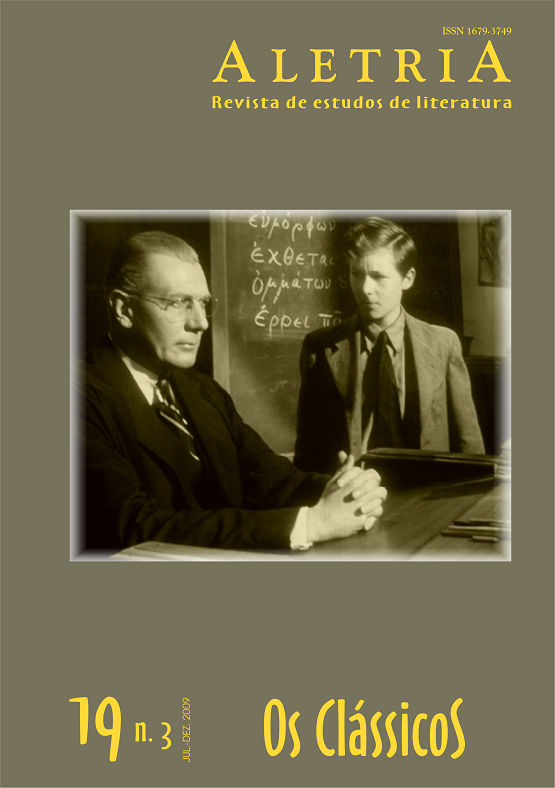VT LEO, MILES: o emprego do símile em Estácio, Siluae 2,5, em contraste com o símile épico na Tebaida e Aquileida
DOI:
https://doi.org/10.17851/2317-2096.19.3.57-70Keywords:
Símile épico, Silvas, Estácio, Epic simile, Siluae, Statius.Abstract
Resumo: O emprego do símile, que traz como elemento-base de comparação o leão (leo), encontra uso e função distintos quando se comparam as suas ocorrências na produção épica estaciana (Tebaida e Aquileida) com a sua manifestação lírica, representada pelo poema 2.5 das Silvas. Busca-se demonstrar neste artigo, de um lado, o contraste entre a figuração típica do leão belicoso e, menos usual, a do leão domesticado; de outro, o fim poético atingido.
Palavras-chave: Símile épico; Silvas; Estácio.
Abstract: The use of the simile having the lion (leo) as its basic element of comparison finds distinct poetic use and function if its textual occurrences in the Statian epics (Thebaid and Aquilleid) and its lyrical manifestation (here represented by Silu., 2.5) are compared. This article aims to show the contrast, on the one hand, between the typical warring lion and the less usual tamed lion, and, on the other hand, the poetic purpose that is thus accomplished.
Keywords: Epic simile; Siluae; Statius.
Downloads
References
ARISTOTE. Rhétorique. Texte établi et traduit par M. Dufour. Paris: Société d’Édition Belles Lettres, 1960. 136 p.
AUGOUSTAKIS, Antony. Unius amissi leonis: Taming the Lion and Caesar’s Tears (Silvae, 2.5). Arethusa, Baltimore, v. 40, n. 2, p. 207-221, Spring 2007.
CICERO. De Oratore: liber III. Texte établi et traduit par Edmond Courbaud. Paris: Société d’Édition Les Belles Lettres, 1930. 117 p.
DOMINIK, William J. Speech and Rhetoric in Statius’ Thebaid. Altertums-wissenschaftliche Texte und Studien, Band 27. Hildesheim; Zürich; New York: Olms-Weidmann, 1994(a). 383 p.
DOMINIK, William J. The mythic voice of Statius: Power and Politics in the Thebaid. Mnemosyne Bibliotheca Classica Batava, Supplementum CXXXVI. Leiden; New York; Köln: E. J. Brill, 1994(b). 212 p.
LEE, G. M. (Ed.). Oxford Latin Dictionary. Oxford: Clarendon Press, 1968. 2.151 p.
MCNELIS, Charles. Statius’ Thebaid and the Poetics of Civil War. New York: Cambridge University Press, 2007. 211 p.
QUINTILIAN. Institution oratoire. 2. ed. Texte établi et traduit par Jean Cousin. Paris: Société d’Édition Les Belles Lettres, 1980. 311 p.
RETÓRICA A HERÊNIO. Tradução e introdução de Ana Paula Celestino Faria e Adriana Seabra. São Paulo: Hedra, 2005. 313 p.
SCHNAPP-GOURBEILLON, Annie. Lions, héros, masques: les représentations de l’animal chez Homère. Paris: François Maspero, 1981. 219 p.
STACE. Silves. 3. ed. Texte établi par H. Frère et traduit par H. J. Izaac. Paris: Société d’Édition Les Belles Lettres, 1992. 288 p.
STATIUS. Thebaid. Edited and Translated by D. R. Shackleton Bailey. Cambridge: Harvard University Press, 2003. v. 1. 459 p. v. 2, 441 p.
STATIUS. Thebaid IX. Edited with an English Translation and Commentary by Michael Dewar. Oxford: Clarendon Press, 1991. 271 p.
VAN DAM, H.-J. Silvae, Book II: A Commentary. Leiden: E. J. Brill, 1984. 539 p.
Downloads
Published
Issue
Section
License
Copyright (c) 2009 Fernanda Messeder Moura (Autor)

This work is licensed under a Creative Commons Attribution 4.0 International License.
Authors who publish with this journal agree to the following terms:Authors retain copyright and grant the journal right of first publication with the work simultaneously licensed under a Creative Commons Attribution Non-Commercial No Derivatives License that allows others to share the work with an acknowledgement of the work's authorship and initial publication in this journal.Authors are able to enter into separate, additional contractual arrangements for the non-exclusive distribution of the journal's published version of the work (e.g., post it to an institutional repository or publish it in a book), with an acknowledgement of its initial publication in this journal.Authors are permitted and encouraged to post their work online (e.g., in institutional repositories or on their website) prior to and during the submission process, as it can lead to productive exchanges, as well as earlier and greater citation of published work (See The Effect of Open Access).









